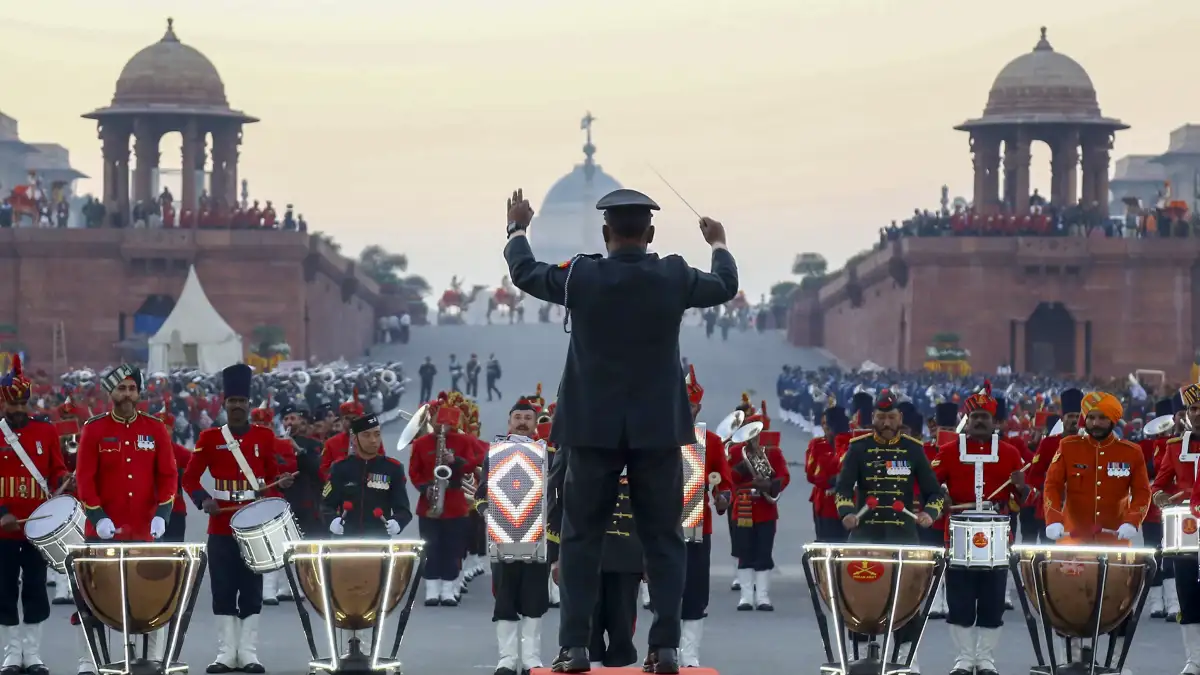
Beating Retreat 2025 ceremony begins at Kartavya Path. The beating Retreat ceremony marks the formal end of the Republic Day celebrations. Prime Minister Narendra Modi has arrived for the Beating Retreat ceremony. President Droudapi Murmu has also reached to witness the ceremony in her Buggy. The ceremony is being attended by Vice President Jagdeep Dhankhar among other dignitories.
From “Kadam Kadam Badhaye Ja” and “Aye Watan Tere Liye” to “Ganga Jamuna”and “Bharat Ke Jawan” — bands from the Indian Army, Navy, Indian Air Force (IAF) and the Central Armed Police Forces (CAPF) played 30 foot-tapping tunes before a distinguished audience comprising President Droupadi Murmu, Vice-President Jagdeep Dhankhar, Prime Minister Narendra Modi, and Defence Minister Rajnath Singh, among others. President Murmu arrived in the traditional buggy with the audience cheering as her open gold-plated carriage rolled down the Raisina hill.
The ceremony began with the massed band’s “Kadam Kadam Badhaye Ja” tune, followed by several captivating numbers such as “Amar Bharati”, “Indradhanush”, “Jai Janam Bhumi”, “Nati in Himalayan Valley”, “Ganga Jamuna” and “Veer Siachen” by the Pipes and Drums band. The CAPF bands played “Vijay Bharat”, “Rajasthan Troops”, “Aye Watan Tere Liye”, and “Bharat ke Jawan”.
“Galaxy Rider”, “Stride”, “Rubaru” and “Millennium Flight Fantasy” were the tunes played by the IAF band, while the Navy band played “Rashtriya Pratham”, “Nishak Nishpad”, “Aatmanirbhar Bharat”, “Spread the Light of Freedom”, “Rhythm of the Reef” and “Jai Bharati’.
It was followed by the Army band which played “Veer Sapoot”, “Taqat Watan”, “Mera Yuva Bharat”, “Dhruv” and “Faulad Ka Jigar”. The Massed Bands then played the tunes “Priyam Bharatam”, “Aye Mere Watan Ke Logon” and “Drummers Call”, drawing loud cheer and applause from the audience.
The event came to a close with the ever-popular tune “Sare Jahan Se Acha”, played by the Buglers. The principal conductor of the ceremony was Commander Manoj Sebastian.
The Army band conductor was Subedar Major (honourary captain) Bishan Bahadur, while M Antony, MCPO MUS II, and Warrant Officer Ashok Kumar were the conductors of the Navy and IAF bands, respectively. The conductor of the CAPF band was Head Constable GD Mahajan Kailash Madhava Rao.
The Pipes and Drums band played under the instructions of Subedar Major Abhilash Singh, while the Buglers performed under the leadership of Naib Subedar Bhupal Singh. The ceremony follows a centuries-old military tradition, wherein troops cease fighting, sheathe their arms, withdraw from the battlefield, and return to their camps at sunset upon the sounding of the retreat.
The first Beating Retreat ceremony in India was held in 1955, during the state visit of Queen Elizabeth II and Prince Philip. It was conceived by Major GA Roberts and commissioned by then-prime minister Jawaharlal Nehru. Since then, the ceremony has become an annual event, showcasing the musical and cultural heritage of India.
Know about history of ‘Beating Retreat’ ceremony
‘Beating Retreat’ traces its origins to the early 1950s when Major Roberts of the Indian Army indigenously developed the unique ceremony of display by the massed bands. It marks a centuries-old military tradition, when the troops ceased fighting, sheathed their arms, withdrew from the battlefield, and returned to the camps at sunset at the sounding of the retreat. Colours and standards are cased, and flags are lowered. The ceremony creates nostalgia for the times gone by.
It is held on the evening of January 29, three days after Republic Day, at the Vijay Chowk, New Delhi. The ceremony features a musical performance by the bands of the Indian Army, Navy, Air Force, Delhi Police, and the Central Armed Police Force (CAPF). The ceremony is presided over by the President of India, who is the supreme commander of the Armed Forces. The beating retreat ceremony in India was first held in the 1950s, during the state visit of Queen Elizabeth and Prince Philip. Since then, the ceremony has become an annual event to pay tribute to the valour and sacrifice of the Indian Armed Forces.
(With Agency inputs)


